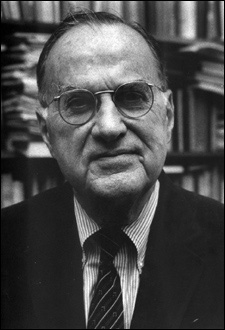Abram Bergson dies at 89:
Economist pioneered rigorous quantitative study of the Soviet economy

Abram Bergson, an economist who pioneered the rigorous quantitative study of the Soviet economy, died April 23 at the age of 89.
A member of the Harvard Economics Department since 1956, Bergson turned his attention to the Soviet Union while still a graduate student at Harvard in the 1930s.
Discussing the reasons behind this interest in a 1987 autobiographical essay, Bergson explained that very little scholarly work had been done on the subject up to that point and that “in the mixed-up world of the time, how socialist planning functioned in the one country where it was being applied on any scale seemed a rather momentous matter.”
When Bergson started on this project, obtaining accurate data on the Soviet economy was extremely difficult. Under Stalin, information was strictly controlled or deliberately falsified, Soviet scholars were prevented from communicating freely, and Americans were generally barred from visiting the Soviet Union.
Another problem was finding a meaningful way of comparing Soviet economic statistics with measures commonly used by Western economists, a problem Bergson solved by formulating the Adjusted Factor Cost Standard, later widely adopted by other scholars in the field.
Applying an objective standard to the Soviet Union’s exaggerated claims of economic growth “was almost a one-man effort” when Bergson started on this work, said Marshall Goldman, associate director of the Davis Center for Russian and Eurasian Research. Goldman studied under Bergson as a graduate student at Harvard in the 1950s.
“He was ‘Mr. Integrity,’” Goldman said of his mentor. “He was very upright, exceptionally precise, very demanding of his students.”
After the Soviet Union collapsed in 1989, Soviet scholars, once forced to adjust their findings to the “Party Line,” were free to express their esteem for Bergson’s work.
“They would make pilgrimages to see him as if they were coming to consult the oracle. It was wonderful to see how much they respected him,” Goldman said.
Bergson’s fellow economist and longtime friend Paul Samuelson, professor of economics emeritus at the Massachusetts Institute of Technology, said that “Bergson would be on anyone’s short list for a Nobel Prize – even two such if collectivist economic systems is regarded as a separate specialty.”
Bergson and Samuelson first met as students in the graduate seminar of Harvard economist Wassily Leontief. An early paper of Bergson’s which offered a precise formulation of what economists refer to as social welfare, proved to be extremely influential. This theory, linked with similar work by Samuelson, became known as the Bergson-Samuelson social welfare function.
James Duesenberry, the William Joseph Maier Professor of Money and Banking Emeritus, called Bergson “a meticulous worker, more concerned with getting it right than with a quick or flashy conclusion.”
Duesenberry also commented on Bergson’s modesty. “When he was named a distinguished Fellow of the American Economics Association he didn’t tell me about it. He just said that he was going to the meeting but didn’t say why until I asked.”
Bergson was director of the Russian Research Center (now the Davis Center) from 1964 to 1968 and acting director from 1969 to 1970. He remained involved in activities at the center until this past fall, frequently leading off the question-and-answer period at lectures and symposia.
Davis Center Director Timothy Colton described Bergson as “a gentleman of the old school, distant at times, but fair. He set high standards for everything. You always checked yourself before talking to him about anything factual, because if not, a cloud would come over his face, and you would know that you’d made a mistake.”
Born in Baltimore, Bergson earned his A.B. degree from Johns Hopkins University in 1933 and his A.M. and Ph.D. from Harvard in 1935 and 1940, respectively. It was while he was a graduate student that he and his brother Gustav, a physicist, decided to change their name to Bergson, because they believed the name they had been born with – Burk – did not clearly convey their Jewish heritage.
Bergson taught at the University of Texas from 1940 to 1942. During World War II he served in the Office of Strategic Services, the predecessor of the Central Intelligence Agency, eventually becoming chief of the Russian economic subdivision. From 1946 to 1956 he taught economics at Columbia University.
His books include: “The Structure of Soviet Wages: A Study in Socialist Economics” (1944); “Soviet National Income and Product in 1937” (1953); “The Economics of Soviet Planning” (1964); “Productivity and the Social System: The USSR and the West” (1978); and “The Soviet Economy: Towards the Year 2000” (coeditor with Herbert Levine, 1983).
He is survived by his wife, Rita Macht-Bergson; his three daughters, Judith Bergson of Somerville, Emily Bergson White of Wellesley, and Lucy Bergson LaFarge of New York City; and three grandchildren.




